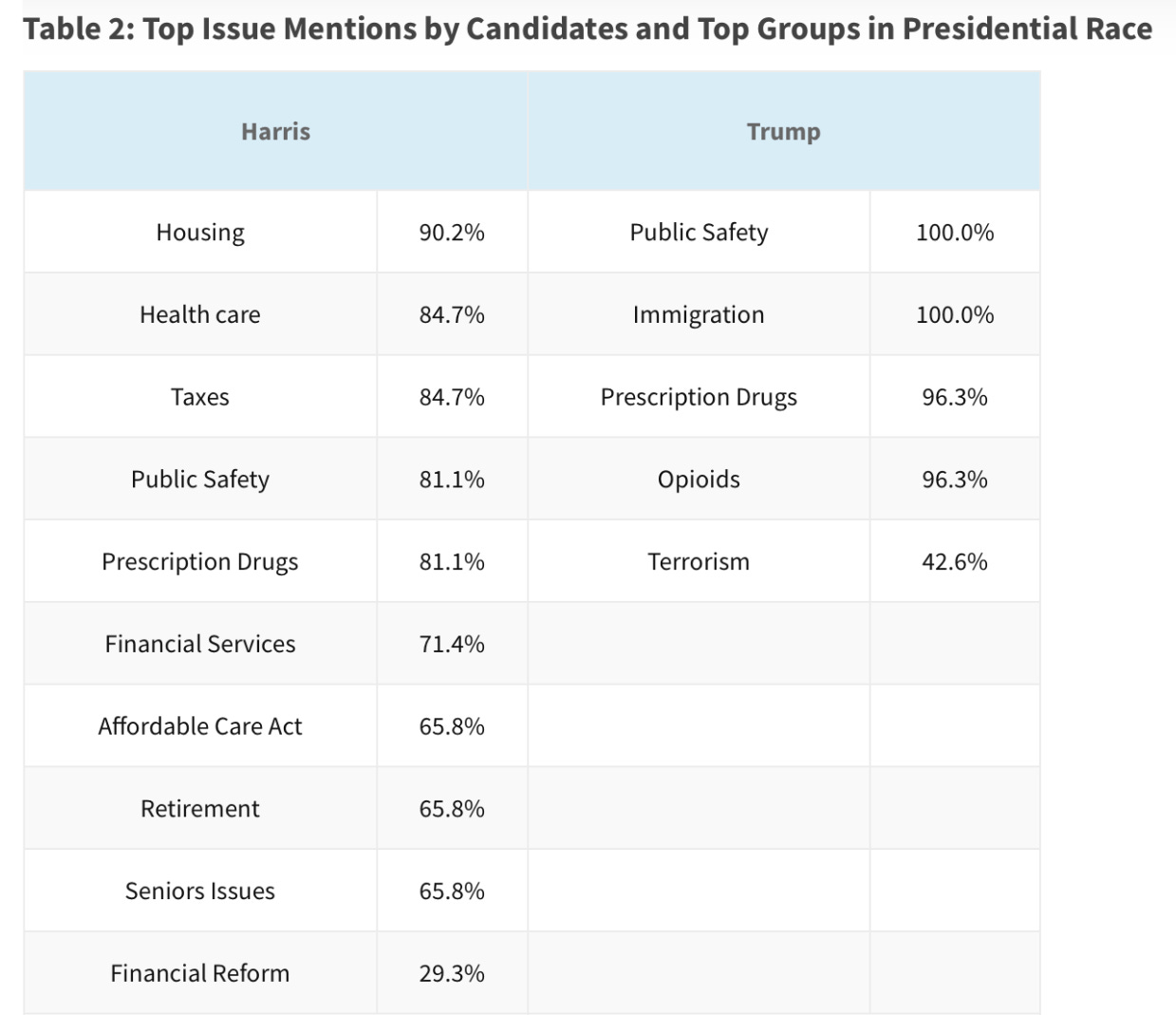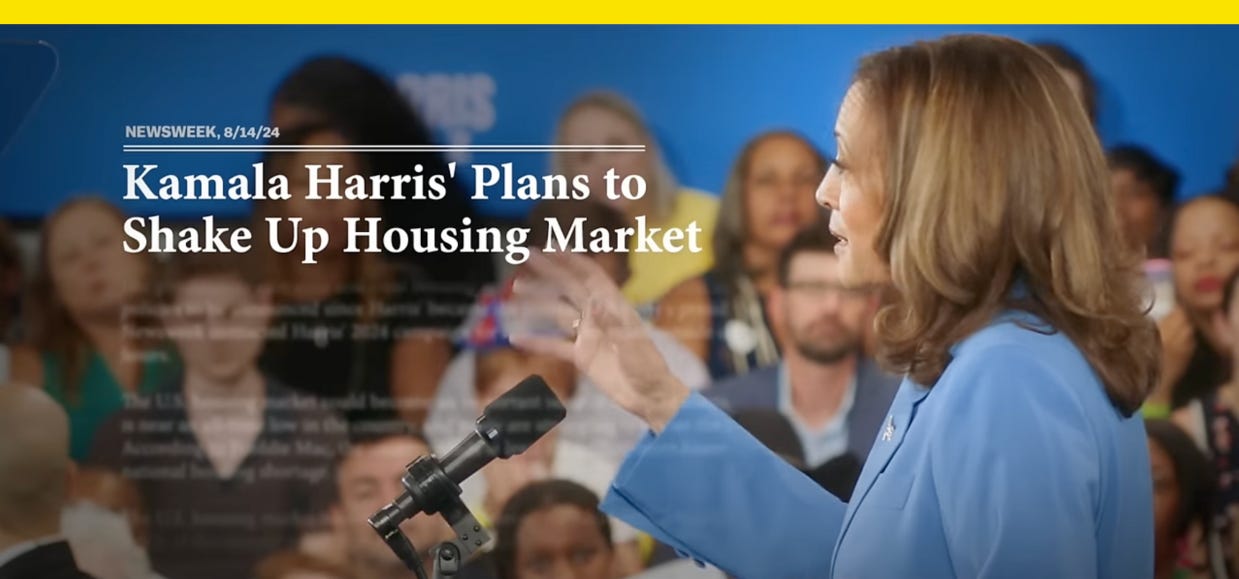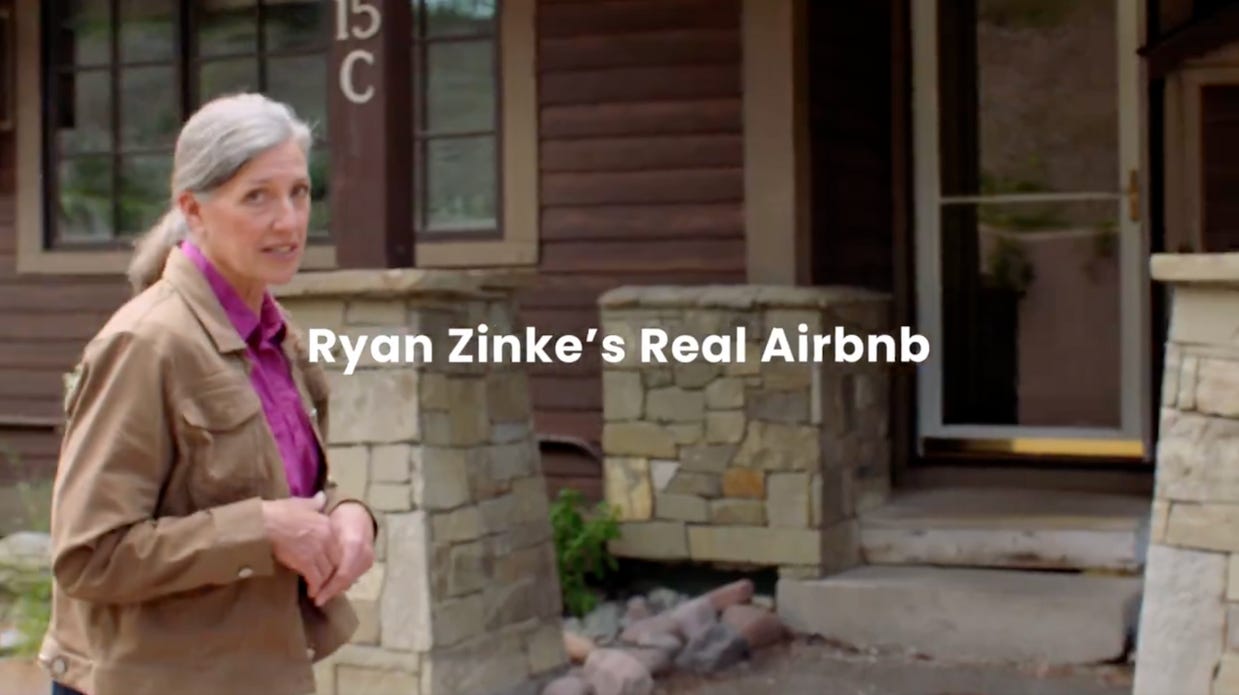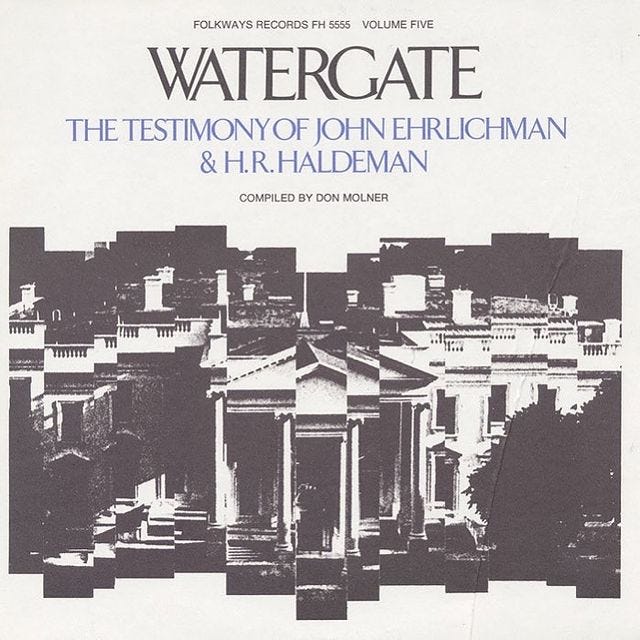The battle over “Project 2025” search results
Plus: There's a major difference in the top issues in Harris' campaign ads vs. Trump's
Hello, in this issue we’ll look at…
There's a major difference in the top issues in Harris' campaign ads vs. Trump's
Here’s how Democrats are bringing up housing affordability in their ads
The battle over “Project 2025” search results
Scroll to the end to see: my new workout playlist 🎧
There's a major difference in the top issues in Harris' campaign ads vs. Trump's
The presidential campaign is shaping up to be a contest about domestic issues.
New analysis from the Wesleyan Media Project found the major party candidates are focused on issues at home more than trouble abroad, but they’re taking two very different approaches to the issues they highlight.
Vice President Kamala Harris’ campaign ads are focused most on housing (90.2%) (see more in the section below), healthcare (84.7%), and taxes (84.7), while all of former President Donald Trump’s campaign ads mention public safety (100%) and immigration (100%).
Overall, Trump is focused on just a handful of issues issues. In addition to public safety and immigration, the survey found 96.3% of his ads mention prescription drugs, 96.3% mention opioids, and 42.6% mention terrorism.
Harris by contrast is touching on more issues in her ads, including public safety (81.1%), which is often brought up by mentioning Harris’ past career as a prosecutor, prescription drugs (81.1%), financial services (71.4%), the Affordable Care Act (65.8%), retirement (65.8%), and senior issues (65.8%).
Outside groups are taking opposite approaches to their advertising. For Trump, his aligned super PAC MAGA, Inc., is following his lead in making immigration (89.2%) and public safety (53.4%) its top issues. For Harris, her aligned super PAC FF PAC is supplementing her advertising with ads about a topic she’s not currently focused on in her advertising but is a major part of her campaign, abortion (71.3%).
“Trump and his allies are airing ads attempting to tie Harris to the border security issues, illegal immigration, and crime while Harris and her allies are touting her record as a prosecutor, background as a daughter of an immigrant, and contrasting her work for for the middle class with that of Trump,” Erika Franklin Fowler, co-director of the Wesleyan Media Project, said in a statement.
The survey found pro-Trump ads are currently out-airing pro-Harris ads. The top ad markets were Phoenix, Philadelphia, Atlanta, Harrisburg, Pa., Pittsburgh, and Tucson, Ariz.
Here’s how Democrats are bringing up housing affordability in their ads
If campaigns hope to reach young voters, talking about housing policy is a good way to get their attention.
A survey of 3,000 homeowners and renters by the real estate services company Redfin found 91% of Gen Z respondents and 87% of Millennial respondents said housing affordability is somewhat or very important to how they plan to vote. Two Democrats have made the issue the focus of new ads.
The Harris campaign turned her recent speech in North Carolina about economic policy into a 60-second ad about her housing plan. “Full House” opens with Harris explaining how her mother saved for more than a decade to buy their first home and continues with her plans to do something about affordability and supply if she takes office.
“I know what homeownership means, and sadly right now it is out of reach for far too many American families,” Harris says.
She says she’ll crack down on the practices of corporate landlords, and the ad is illustrated with news headlines, like “3 Million New Housing Units,” a truncated headline from the Wall Street Journal about Harris’ plan to increase homebuilding and offer subsidies to home builders and buyers to boost supply.
The ad is part of the Harris campaign’s $90 million ad buy for the end of August that will air in swing states on local broadcasts, cable programming, and shows including “The Bachelorette,” “The Daily Show,” “The Simpsons,” and “Love & Hip Hop: Atlanta.”
In Montana, Olympic rower and Democratic U.S. House candidate Monica Tranel filmed an ad at a home she says is listed on Airbnb by her opponent, incumbent Rep. Ryan Zinke (R-Mont.). In the 30-second video, Tranel tours the home, motions to the bad wall art of a dog wearing glasses and a hat, and attempts to connect Zinke’s time as Interior Secretary to his side gig as a landlord.
“As Interior Secretary, Zinke tried to cash in by selling off Montana’s land to international developers,” Tranel says. “Now, he’s buying up properties across Montana and jacking up the rent.” She says “housing profiteers” like Zinke “are the reason it’s so expensive to live here.” Landlord-politicians, beware, your investment properties could end up in an attack ad.
Homebuilding is local, so even as affordability has become a major national issue, expect to see more from state and local campaign advertising about candidates’ plans to deal with affordability in their own communities.
The battle over “Project 2025” search results
When Taraji P. Henson hosted the BET Awards in July, she told viewers to look up Project 2025. They did. Search interest for Project 2025, the blueprint for a second Trump term in the White House written by the conservative think tank Heritage Foundation and other groups with ties to the former president’s administration, peaked in the days after the awards show. Suddenly the focus of the 2024 campaign was about policy, and voters were turning to search to learn more.
Page one of Google has long been among the most important web pages in U.S. politics, but it’s taken on new significance in the presidential campaign thanks to Democratic calls to “Look Up Project 2025.” Democrats didn’t seem ready for what people might find when they followed suit, though. Rather than campaign ads at the top of the search page, it’s nonprofits, think tanks, and news outlets that have savvily SEO engineered their way to the top.
The anti-extremism nonprofit Global Project Against Hate and Extremism, or GPAHE, is among the top-sponsored results when searching for more information related to Project 2025. The group, founded in 2020 by Southern Poverty Law Center alumni Heidi Beirich and Wendy Via, started its campaign in fall 2023, after the Heritage Foundation released Project 2025 the previous spring. A Google Ads campaign using $10,000 in free monthly credits available to qualifying nonprofits drove traffic to a comprehensive report authored by GPAHE on Project 2025, months before it became a top search term.
“That was a way to leverage a resource without having to actually cost the organization a lot of money but build awareness, build engagement, and drive referrals and clicks to their report,” Kindred Motes, founder and managing director of the social impact firm KM Strategies Group, which built the campaign for GPAHE, tells me.
The campaign used not only search terms directly related to Project 2025, but also search terms for policy areas in the report, like abortion bans and threats to LGBTQ+ rights and equality. The Google Ads campaign for GPAHE has generated nearly 1 million impressions, more than 100,000 clicks, and a 12% click-through rate, Motes says, noting, “It was at the time the most robust and comprehensive summary of Project 2025; what it would actually mean, what it aims to do. They [GPAHE] were looking for ways to build awareness for Project 2025 because it wasn’t really in the public discourse or driving any kind of conversation.”
In July, President Joe Biden asked his followers to Google “Project 2025.” His campaign sold stickers that directed people to look it up with a QR code that linked to a campaign microsite with more information. However, if you were to Google “Project 2025” in July, the top result would have been the Heritage Foundation’s website with no links to the Biden campaign’s site. The campaign seemed ill-prepared for people to follow up on its call to action.
Since then, it’s clear Democrats have succeeded in raising awareness about Project 2025—so much so that Trump has tried distancing himself from it. When Harris mentioned it in her acceptance speech at the Democratic National Convention, she didn’t have to introduce it or ask viewers to look up anything. “We know what a second Trump term would look like,” she said. “It’s all laid out in Project 2025, written by his closest advisers, and its sum total is to pull our country back to the past.”
Trump’s campaign isn’t running Google Ads about Project 2025, while Harris’ is, but they’re crowded out by plenty of other advertisers. Web pages from the Heritage Foundation and GPAHE are still among the top paid search results for Project 2025, as are sponsored links from the likes of the labor unions group AFL-CIO and American Rivers, which advocates for healthy rivers and clean water and warns about the environmental impact of Project 2025. Media organizations have sponsored links of their own, including the Texas-based nonprofit, independent news outlet The 19th, which covers gender, politics, and policy and linked to its own primer.
Interest in Project 2025 started on TikTok and Instagram before migrating to search, and Motes says he noticed “there was almost no awareness whatsoever among Gen X and Baby Boomers” because Google is their primary information vehicle versus Millennials and Gen Z, for whom its social media.
“Search is absolutely critical,” he says. “It is not only a place where people find information, it’s a place where information is generated, gathered, and re-created.”
Have you seen this?
DNC 2024: Harris memes-turned-ephemera head to the Smithsonian. “In our collection, we have convention badges for media going back to the early days of the 20th century. Some of them will say ‘telegraph operator.’ Some of them will say ‘newspaper.’ They’re very specific. We don’t probably have any telegraph operators working media at this convention. Now it’s ‘influencer.’” [Fast Company]
Political merch surge reflects growing voter enthusiasm. Creator-journalist Hunter Schwarz said the popularity of these items speaks to the connection between campaigns and supporters. [Spectrum News]
Trump camp spends tens of thousands to air ads in and around Mar-a-Lago. Florida’s not at risk. But staffers are risking anger from the boss (and some donors) if he doesn’t see his own ads. [The Bulwark]
Mark Zuckerberg says he’s staying “neutral” on politics. In a letter to Rep. Jim Jordan (R-Ohio), chair of the House Judiciary Committee, Zuckerberg said Biden administration efforts to censor misinformation about the COVID-19 pandemic were wrong. [Whig]
Why Walz’ campaign coachcore connects with voters. Tim Walz is a dad. He’s a husband. A Midwesterner who likes to hunt. And a governor. He also happens to be a former high school football coach—and the Harris-Walz campaign is here to remind you of that. [Yello]
History of political design
Volume five of the Folkways Watergate Series (1975). The 10-track record was made up of audio from the testimony of then-President Richard Nixon’s chief of staff H.R. Haldeman and White House counsel John Ehrlichman during a 1973 U.S. Senate hearing into the Watergate break-in. This month marks the 50th anniversary of Nixon’s resignation.
A portion of this newsletter was first published in Fast Company.
Like what you see? Subscribe for more:









